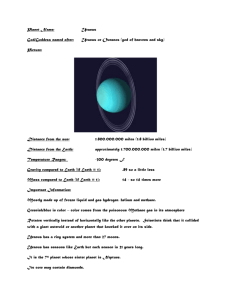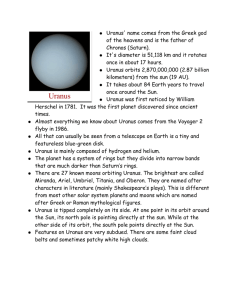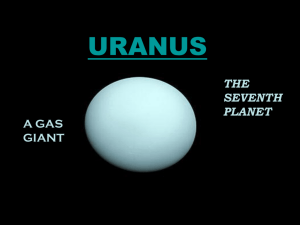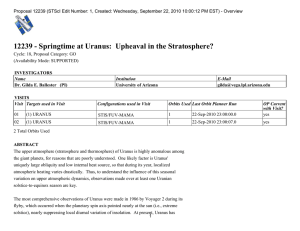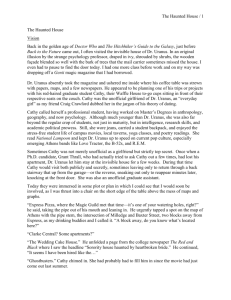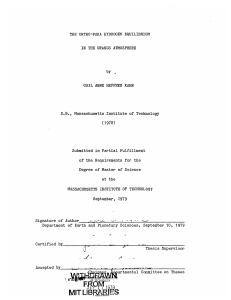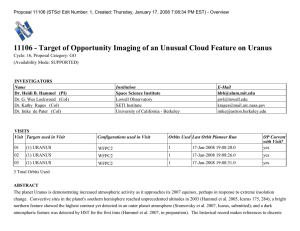Uranus
advertisement
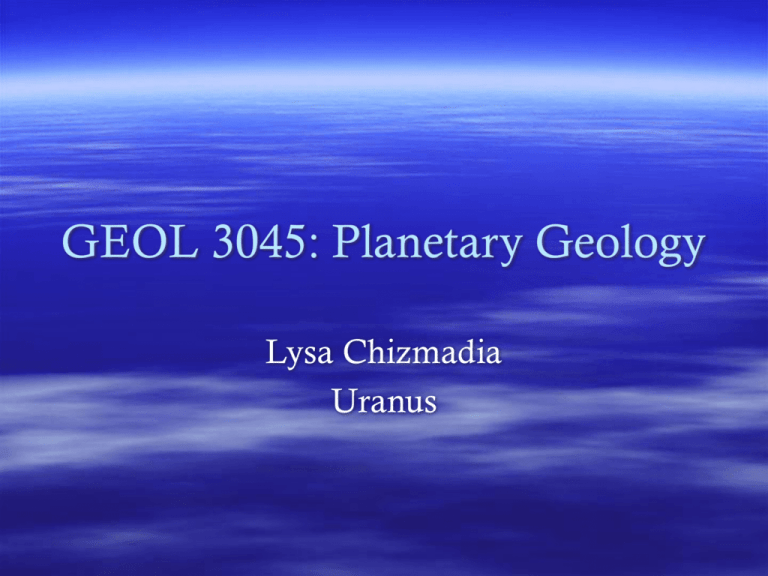
GEOL 3045: Planetary Geology Lysa Chizmadia Uranus Introduction 3rd largest planet – Seventh from Sun (or eighth) 1st discovered in modern times – 1781 by William Herschel Eccentricity = 0.046 Image from: http://www.solarviews.com/eng/uranus.htm – 18 - 20 AU Axial Tilt = 97.9º – Earth = 23.5º Orbital period = 84.1 years – Each pole 42 years continuous Sun, then dark Rotational period = 17.9 hours Mass = 8.69 x 1025 kg – ~14.5 Earths Average = 1.29 g/cm3 – = 5.52 g/cm3 (2nd lowest in solar system) At least 27 moons Image from: http://en.wikipedia.org/wiki/Uranus Internal Structure Atmosphere: – Pressure: 1.2 bars Earth: ~ 1 bar – Outer 20% of radius ~0.5 Earth masses – ~83% H, ~15% He & 2% CH4 Blue color due to absorption of red light by methane Icy mantle – – – – ~13.4 x Earth masses Hot dense fluid Composition: H2O, NH3, etc. High electrical conductivity Rocky Core: – – – – ~0.55 x Earth masses ~ 9 g/cm3 P ~ 8 Mbars T ~ 5000 K Image from: http://www.solarviews.com/eng/uranus.htm Atmosphere Structure: – Troposphere Highly complex cloud structure – – – – False color showing banding H2O clouds NH4HS clouds NH3 or H2S clouds CH4 Responsible for Far IR emissions – T ~ 59 K – Stratosphere Contains H-Cs formed from UV radiation of CH4 May be responsible for bland appearance – Thermosphere/Corona H2 and H Extends 2 Uranus radii (~8 Earth radii) Images from: http://en.wikipedia.org/wiki/Uranus Dark Spot Climate At equator, winds retrograde White Storm – 50-100 m/s Wind speeds to 60 lat – 150-200 m/s Towards poles, winds prograde At poles, winds fall to 0 m/s Dark spots common on Neptune never observed on Uranus until 2006 Images from: http://en.wikipedia.org/wiki/Uranus Inner Rings Rings Dark ring system 2nd discovered At least 13 distinct rings Opacity & gaps indicate recent formation Probably from shattered satellite Fine Structure False color to show structure Shepherd Satellites Images from: http://www.solarviews.com/eng/uranus.htm Images from: http://en.wikipedia.org/wiki/Uranus Magnetic Field ~50 x Earth’s magnetic field Tilted 59 from rotation axis Not centered with planet – ~1/3 towards south pole Therefore, highly asymmetric – Strength in S ~0.1 G – Strength in N ~1.1 G ~ Neptune May be generated in CH4H2O ocean instead of in core Image from: http://en.wikipedia.org/wiki/Uranus Heat Output Coldest of giant planets – 49 K (~ same as Pluto) Neptune radiates 2.6 x more heat than receives from Sun – Uranus radiates almost none Heat flux < Earth Hypotheses: – When knocked over, lost primordial heat – Barrier in atmosphere prevents heat from reaching space Image from: http://en.wikipedia.org/wiki/Uranus Summary 1st discovered in modern times 2nd least dense planet Internal structure – Atmosphere – Icy mantle (hot, dense liquid) – Rocky core Rotates on side – Probably due to massive collision Complex atmospheric structure – Troposphere – Stratosphere – Thermosphere/Corona Asymmetrical magnetic field Coldest of giant planets Image from: http://en.wikipedia.org/wiki/Uranus
